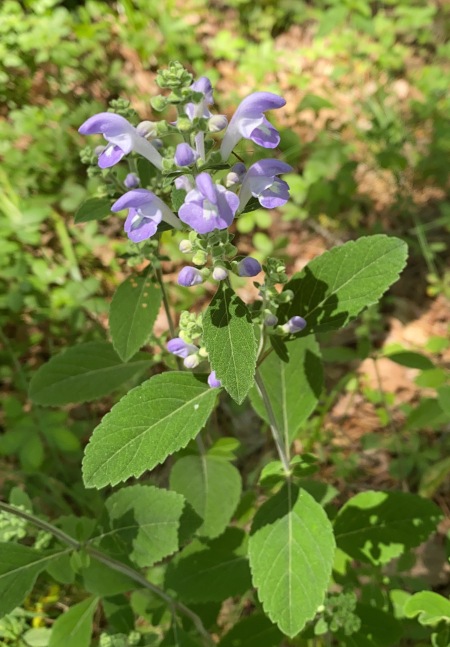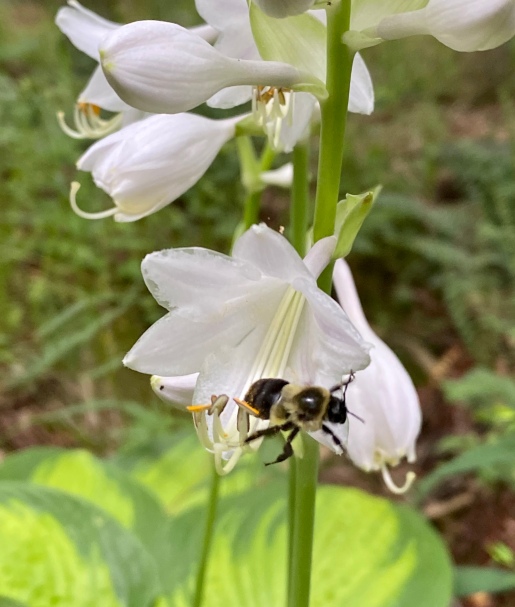1. I’m going to start out immediately with my first entry, because I’ve been waiting for these North American natives to bloom for a couple of weeks now–and for a couple of reasons. I look for the black-eyed Susans (Rudbeckia hirta) to bloom because they signal my birthday. I also am happy to see them bloom because after they do, I can finally mow the “weeds” in the wooded area of the garden. From March through June, the forest floor gives me dwarf irises, crane-fly orchards, woodland phlox, fleabane daises, rosin weed, and several other natives short and tall. But it also gives me some spiny grasses and other carry-along seeds that grab on to my shoe laces, socks, shirttails, and my dog’s fur, which neither Rosie nor I appreciate. I still have to be mindful of Carolina lilies that will not bloom until summer and a few other flowering natives, still I’ll be able to mow a few paths under the trees.
Of course, there is another reason to welcome the black-eyed Susans; they are bright, cheery, and pretty. The deep yellow petals are pleasant to see scattered throughout the garden, both under the trees (with generally smaller flowers) and in sunnier areas. In addition, I can count on them to self-seed.
2. There is another native wildflower blooming, which I confess I have not valued much in the past. I looked at it more closely this week and decided that I need to be more mindful of this little skullcap (Scutellaria). I can’t identify the species given that there are over 300 in this genus of the mint family. Still, I did discover that it seems to have an interesting history of medicinal use as well as having an attractive, if diminutive, flower.

3. Hostas began blooming a week or more ago. In the first photo below, the flowers seem to have a violet tinge. However, they are a clean white that sets them off well over the variegated hosta leaves and across the dry creek bed from the ferns. Not surprisingly, the bees found them attractive as well.

4. In a previous Six on Saturday post I highlighted the Stella d’Oro daylily (Hemerocallis “Stella d’Oro”). They are still producing a few blooms, but other day lilies are blooming now as well. The one below has a lovely large bloom; unfortunately, I lost track of its name a few years ago. It is somewhere in my records–somewhere.
The daylily below can be seen blooming now just about everywhere in Blount County, Alabama. And I know its name, Hemerocallis fulva. It is called by many other common names, however, including orange lily, tiger lily, and the far less polite, ditch lily. It does, in fact, grow freely in ditches along the roadside, though. But as the second photo attests, some varieties have a rather lush display of petals.
5. Number five is not really in the garden, but on the hill leading down to the lake. I wanted to include it because it had an abundant bloom this year. I can’t say that I have a great love for this succoring, tall shrub, the American Black Elderberry (Sambucus canadensis). Every winter when it loses its leaves, I cut the new stalks out, otherwise I think it would take over much of the hill. Nonetheless, these flower clusters deserve some celebration.
6. My final entry also relates to the hill. Shortly after Mr. Snow, my tree man, removed the trees felled during the Easter Sunday storms, another wind brought a gigantic, dead pine limb down in an area I had just meticulously cleaned of small branches and debris. The large rock center-left in the second photo is one I like to view the lake from. I prize this little outlook and want it open and safe, so it was my task to clear the hill of debris again. This past week I took the job on. I still have quite a lot to burn, but the pine is down to its skeleton limbs, and the twigs and branches are neatly stacked. Best of all, I got to use my new chainsaw sharpener! During lock-down the most amazing things can become welcomed adventures.

I think the chainsaw sharpener is a good pace to stop for this week. I hope everyone remains healthy and invite all to visit The Propagator’s blog for another series of six garden notes and links to many more.














Great way to start my day – thank you for sharing!
LikeLiked by 1 person
Love the hostas—and that chain saw sharpener!
LikeLiked by 2 people
And it worked well, too!
LikeLike
This past year was the first I left my black-eyed Susans alone, to “test” if they were indeed perennial! Around here people use them as annuals. But, I found out they are, and the plants are so big and sturdy! I love ditch lilies, I actually bought some! I probably like them better than the daylilies I have.
LikeLiked by 2 people
I confess that I like them, too. Especially the fancier ones. Too bad you don’t live nearby. I could give you dozens. They are prolific!
LikeLike
Nice Six! I enjoy rudbeckia here, but have to restart them every couple of years since they’re neither native nor love our climate. They remind me of our years back east. So great that you grow them easily. Elderberries are here in the hundreds however, on the wild part of our land in particular, and offer a lovely backdrop plus loads of fruit for birds.
LikeLiked by 2 people
That hosta is reverting to unvariegated foliage. The green unvariegated shoots grow faster than the variegated growth, so will eventually overwhelm and replace the variegated growth if they are not removed. There is probably no rush. If you can somehow tie something around the bases of the green shoots (later, when they stop growing for the year) to identify them when the foliage dies back, it would be best to remove them while they are dormant later. The green shoots can be separated and planted somewhere else.
That black elderberry is rad! I can not get them here because they are quarantined in California. However, I am more than pleased with the native blue elderberries.
LikeLiked by 1 person
yikes, chainsaws are terrifying. borrowed one once (no training, obvs), nigh on decapitated myself. phew. i have rudbeckia goldsturm, they are not close to flowering yet, but they are sturdy plants, planted last year as divisions of a bargain plant or two.
LikeLiked by 1 person